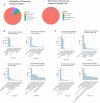Applications and techniques of single-cell RNA sequencing across diverse species
- PMID: 40698863
- PMCID: PMC12284766
- DOI: 10.1093/bib/bbaf354
Applications and techniques of single-cell RNA sequencing across diverse species
Abstract
Single-cell ribonucleic acid sequencing (scRNA-seq) is an important tool in molecular biology, allowing transcriptomic profiling at the single-cell level. This transformative technology has provided unprecedented insights into cellular heterogeneity, lineage differentiation, and cell-type-specific gene expression patterns, significantly advancing our understanding of complex biological systems. scRNA-seq is broadly applied across various fields, including oncology, where it sheds light on intratumoral heterogeneity and precision medicine strategies, and developmental biology, where it uncovers cellular trajectories in both model and non-model organisms. Additionally, scRNA-seq has been instrumental in ecological genomics, which can help elucidate cellular responses to environmental perturbations and species interactions. Despite these advancements, several challenges remain, particularly technical and financial barriers, limiting its application to non-model organisms and tissues with complex cellular compositions. Addressing these issues will require continued innovation in single-cell isolation methods, cost-effective sequencing technologies, and sophisticated bioinformatics tools. As scRNA-seq advances, it can deepen our understanding of biological systems, with broad implications for personalized medicine, evolutionary biology, and ecological research.
Keywords: applications; cell differentiation; non-model organisms; single-cell RNA sequencing.
© The Author(s) 2025. Published by Oxford University Press.
Figures


Similar articles
-
Enabling scalable single-cell transcriptomic analysis through distributed computing with Apache spark.Sci Rep. 2025 Jul 29;15(1):27713. doi: 10.1038/s41598-025-12897-5. Sci Rep. 2025. PMID: 40731055 Free PMC article.
-
Reference Vector-guided Evolutionary Algorithm for cluster analysis of single-cell transcriptomes.Comput Methods Programs Biomed. 2025 Sep;269:108873. doi: 10.1016/j.cmpb.2025.108873. Epub 2025 Jun 6. Comput Methods Programs Biomed. 2025. PMID: 40499345
-
A systematic review of single-cell RNA sequencing applications and insights in Oryza sativa response to environmental stresses.Mol Biol Rep. 2025 Jul 19;52(1):739. doi: 10.1007/s11033-025-10836-1. Mol Biol Rep. 2025. PMID: 40682700 Review.
-
Rethinking eco-evo studies of gene expression for non-model organisms in the genomic era.Mol Ecol. 2025 Aug;34(15):e17378. doi: 10.1111/mec.17378. Epub 2024 May 9. Mol Ecol. 2025. PMID: 38721834 Review.
-
ScInfeR: an efficient method for annotating cell types and sub-types in single-cell RNA-seq, ATAC-seq, and spatial omics.Brief Bioinform. 2025 May 1;26(3):bbaf253. doi: 10.1093/bib/bbaf253. Brief Bioinform. 2025. PMID: 40471991 Free PMC article.
References
-
- Li J, Wang H, Li C. Single-cell sequencing on marine life: Application and future development. Front Mar Sci 2022;9:906267. 10.3389/fmars.2022.906267 - DOI
Publication types
MeSH terms
Grants and funding
LinkOut - more resources
Full Text Sources
Research Materials

